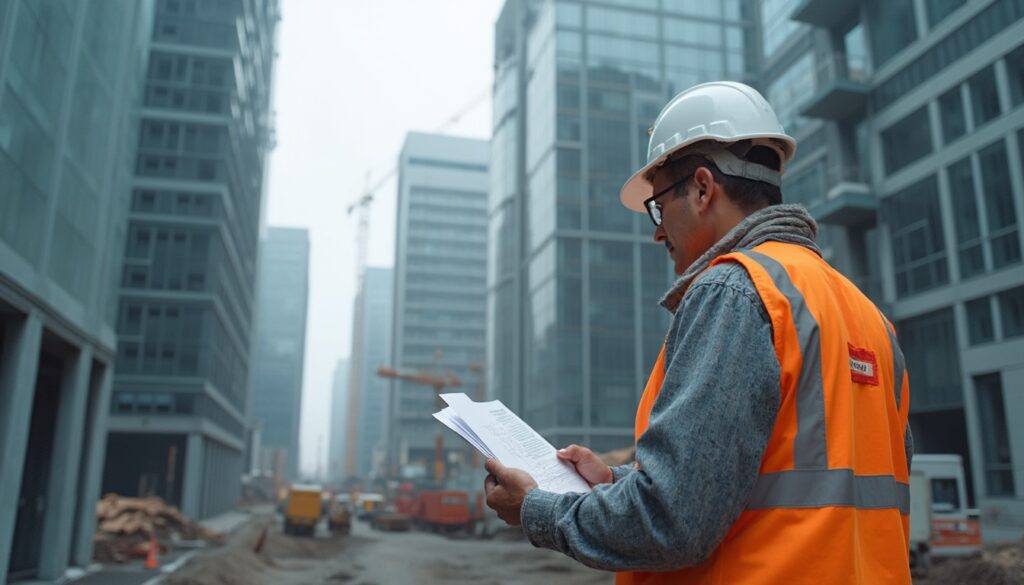Defect notification according to VOB/B §13 No. 5: This is how you lay the foundation for successful project completions
What exactly is a defect notification after acceptance according to VOB/B §13 No. 5?
Let’s be honest, legal documents often sound dry. But a defect notification after acceptance VOB/B §13 No. 5 is much more than just a piece of paper. Think of it as a formal notice to your contractor, informing them of defects that have arisen after the construction acceptance and requesting their rectification. This important document, the defect notification after acceptance VOB/B §13 No. 5, is not just information; it is a vital legal tool that paves the way for your warranty claims. The proper formulation and delivery of such a defect notification after acceptance VOB/B §13 No. 5 are worth their weight in gold here, as mistakes can quickly lead to losing your rights. In daily construction work, this means: Any deviation from what was agreed upon or the accepted standards of technology must be documented precisely. The challenge is often to distill the many observations from the construction site into a structured and legally secure form, as required for a defect notification after acceptance VOB/B §13 No. 5 defect notification. This is precisely where we at Valoon GmbH come in with our digital solutions, like our defect management app, to simplify this process and optimize data collection.
- Formal notice: Informs the contractor about defects that occurred after acceptance.
- Legal tool: Paves the way for warranty claims and urges defect rectification.
- Crucial importance: Secures your rights to rectification, reduction, or damages.
- Documentation duty: Requires precise documentation of deviations from the agreed or the rules of technology.
Why is the defect notification after acceptance so crucial?
It cannot be emphasized enough: A correct defect notification after acceptance VOB/B §13 No. 5 is incredibly important. It is your first and most important step to secure your warranty claims under § 13 VOB/B . Without a properly formatted and timely defect notification after acceptance VOB/B §13 No. 5 , you as the client risk losing your rights to rectification, reduction, or even damages. It gets particularly tricky due to the reversal of the burden of proof after acceptance: Now you must prove that the defect was present at the time of acceptance or was caused by the contractor’s work. A detailed and well-documented defect notification after acceptance VOB/B §13 No. 5 is your strongest argument here. For contractors, a clear notification means they can respond quickly and fend off unjustified claims. An efficient defect tracking via construction app helps both parties keep an overview and avoid misunderstandings from the outset.
What to expect in this article: A comprehensive overview for builders and contractors
With this article, we aim to provide you with a clear overview of the requirements and possible pitfalls of the defect notification after acceptance VOB/B §13 No. 5 . We will look together at the legal foundations, explain what is formally and substantively required in a defect notification after acceptance VOB/B §13 No. 5 defect notification, and outline the rights and obligations arising from it for both parties. Our goal is to equip you with the knowledge necessary to avoid mistakes and effectively enforce your claims – or to behave properly as a contractor. A good understanding of the process surrounding the defect notification after acceptance VOB/B §13 No. 5 defect management is a crucial building block for successful defect managementand significantly aids in reducing conflicts. At Valoon GmbH, we are dedicated to simplifying and making such complex processes transparent with innovative software solutions, allowing you to focus entirely on your core business. Discover how our experience and tools can make your construction projects more efficient.
VOB/B §13: Overcoming legal hurdles with defects – Acceptance as a key moment
VOB/B or BGB – Which applies now? defect notification after acceptance VOB/B §13 No. 5A fundamental question that often arises at the outset: Do the regulations of the General Terms and Conditions for Construction Services Part B (VOB/B) or the Civil Code (BGB) come into play regarding defect claims? This is particularly important for the . It is important to know: The VOB/B is not a given; it must be explicitly agreed upon between you and your contractual partner, especially regarding the validity of a defect notification. If this has not occurred, the rules of contract law in the BGB apply. Especially in construction contracts, particularly with public clients or between construction companies, the VOB/B is common practice and often the better choice, as it has specific rules for construction services – like our §13 VOB/B for defect claims. You should definitely know which law applies, as deadlines, formal requirements, and what legally follows from a defect notification after acceptance VOB/B §13 No. 5 geht. Ist das nicht passiert, gelten die Regeln des Werkvertragsrechts im BGB. Gerade bei Bauverträgen, vor allem mit öffentlichen Auftraggebern oder zwischen Baufirmen, ist die VOB/B aber gang und gäbe und oft auch die bessere Wahl, weil sie eben spezielle Regeln für Bauleistungen parat hat – wie unseren §13 VOB/B für Mängelansprüche. Welches Recht gilt, sollten Sie unbedingt wissen, denn Fristen, Formvorschriften und was rechtlich aus einer defect notification after acceptance VOB/B §13 No. 5 defect notification can vary significantly. A false assumption here can lead to really unpleasant consequences.
Examining §13 VOB/B closely: What is behind warranty and defect claims?
§13 VOB/B is essentially the pivot point for defect claims when a VOB/B contract is underlying. It exactly stipulates what the contractor must be liable for (warranty) and when a defect actually exists. For our defect notification after acceptance VOB/B §13 No. 5 defect notification, subsection 5 of this paragraph is particularly important. The correct application of §13 VOB/B is crucial for the effectiveness of your defect notification after acceptance VOB/B §13 No. 5. It states that you, as the client, must formally notify defects that appear after acceptance and before the expiration of the statute of limitations for defect claims in writing. A very important point after acceptance is the defect notification after acceptance VOB/B §13 No. 5 schriftlich rügen müssen. Ein ganz wichtiger Punkt nach der Abnahme ist die reversal of the burden of proof: From now on, you must prove that the defect was caused by the contractor’s non-compliant performance and was already present at the handover of responsibility (transfer of risk). This is a core aspect when preparing a defect notification after acceptance VOB/B §13 No. 5defect notification. A comprehensive documentation, preferably supported by a digital defect management, is crucial for you as the client to give weight to your claims.
What does ‘Acceptance’ actually mean legally?
Acceptance is a truly important moment in the construction contract – a genuine turning point. With the acceptance according to §12 VOB/B, you, as the client, essentially say: ‘Yes, the performance is as we agreed.’ This has some significant consequences: The remuneration becomes due, the clock for the limitation period of defect claims starts ticking, and the risk for the construction work shifts to you. And, as already mentioned, the burden of proof for defects turns. Therefore, our tip: Check everything very carefully before acceptance, and ideally use a checklist for legal acceptance.. If you discover defects during acceptance, they must be documented in the acceptance protocol to secure your rights, which could also influence the later necessity of a defect notification after acceptance VOB/B §13 No. 5 defect notification.
Why the acceptance protocol is so important
The acceptance protocol is one of the most important documents in the entire construction process and also plays a significant role for the defect notification after acceptance VOB/B §13 No. 5 . In it, you record how the construction work looked at the time of acceptance, what defects may have already been noticed, and whether you, as the client, have any specific reservations. A detailed acceptance protocol according to VOB, signed by both parties, is a strong piece of evidence, even in the context of a later defect notification after acceptance VOB/B §13 No. 5defect notification. Warning: If defects are noticed during acceptance but not documented in the protocol and you do not express a reservation, you can lose your claims as a result (§ 640 Abs. 3 BGB, § 12 Abs. 5 No. 1 VOB/B). The digital recording and management of such protocols, as we offer at Valoon GmbH with our software, help you ensure everything is thoroughly and transparently documented, which is advantageous for any potential defect notification after acceptance VOB/B §13 No. 5 claims.
And what if acceptance is refused?
As a client, you can refuse acceptance if serious defects are present (§12 Abs. 3 VOB/B). A defect is serious if it hinders the proper use of the construction work or if important, guaranteed features are missing. However, for minor, insignificant defects, you cannot refuse acceptance – these must be included in the protocol and rectified later under the warranty. If you rightfully refuse acceptance, the typical consequences of acceptance (payment due, limitation begins, risk transfers, burden of proof reverses) do not initially occur. The contractor must then eliminate the defects and ensure everything becomes ready for acceptance. It is important here that you document the reasons for your refusal precisely, which could serve as the basis for a later defect notification after acceptance VOB/B §13 No. 5 defect notification, should not all defects be rectified.Defect notification VOB/B §13 No. 5: This is how it must look – Format, content, and tips for watertight claims
The format must be right: What to consider for the defect notification
In order for your defect notification after acceptance VOB/B §13 No. 5 to really count, certain formal rules must be followed. According to §13 Abs. 5 No. 1 VOB/B, the defect notification after acceptance VOB/B §13 No. 5 must be in writing. Even though emails are commonplace today, caution is advised here: For example, the Frankfurt Regional Court has ruled that a standard email without a qualified electronic signature does not qualify as ‘in writing’. If you want to be absolutely sure, send your defect notification after acceptance VOB/B §13 No. 5 per registered mail with return receipt. This way, you can later unequivocally prove that it has been received by the contractor. This strict rule highlights how important it is to handle communication in construction carefully. Digital helpers like a digital defect collection tool can greatly assist you in preparing and documenting your defect notification after acceptance VOB/B §13 No. 5 , but sometimes the final sending must take the classical route.
- Adhere to written form: Die defect notification after acceptance VOB/B §13 No. 5 must be in writing according to VOB/B §13 Abs. 5 No. 1.
- Choose secure delivery: Sending via registered mail with return receipt is recommended to prove the receipt.
- Specify the correct recipient: The notification must be addressed to the contractor mentioned in the construction contract.
- Describe the defect precisely: A detailed description of the defect (location, type, effects) is essential, ideally with photos.
- Set a reasonable deadline: A realistic deadline for defect rectification with a specific end date must be established.
The right recipient: Small detail, big impact
Not only does the written form matter, but also the correct address on the defect notification after acceptance VOB/B §13 No. 5 is a point that is often overlooked, but is extremely important. The defect notification after acceptance VOB/B §13 No. 5 notification must of course go to your contractual partner, that is, the contractor named in the original construction contract. If it is a company, ensure that the notification goes to the official business address and perhaps even to a person who is listed in the contract as authorized to receive. Mistakes here can mean that the defect notification after acceptance VOB/B §13 No. 5 notification is deemed not properly delivered, and you could miss important deadlines. So: Better to check the contract documents one more time! A central project database, like the one we offer at Valoon GmbH, can help you keep the correct and current address details of all project participants handy.
What should be included? The content of a defect notification
In order for your defect notification after acceptance VOB/B §13 No. 5 to really have an impact must contain certain information. Only then can the contractor examine and rectify the defect. The most important thing in a defect notification after acceptance VOB/B §13 No. 5 defect notification is a precise description of the defect: Where exactly is the defect (e.g., which component, which room, where exactly in the room)? How does it look or manifest (e.g., cracks, damp spots, something doesn’t work)? Photos and plan cutouts are invaluable here! Describe the effects of the defect, but do not speculate on the cause – that is the contractor’s job. Additionally, you must set a reasonable deadline for defect rectification. What is considered ‘reasonable’ depends on the nature and extent of the defect. And of course, a clear request to rectify the defect must be included. The question ‘What should a defect notification according to VOB look like?’ can thus best be answered with ‘detailed!’ especially when it concerns a defect notification after acceptance VOB/B §13 No. 5 significant defect.
Describe the defect precisely: Clarity creates remedy
A precise defect description is really key to a successful defect notification after acceptance VOB/B §13 No. 5defect notification. Vague statements like ‘Window leaky’ do not help anyone. Better is: ‘In the living room, the left window (according to plan pos. 3.2) is leaking at the bottom seal. When it rains, water comes in, and the windowsill and wall next to it are visibly damp over an area of about 20×30 cm.’ Photos and exact location details are indispensable here. The goal is to describe the defect so clearly that the contractor can immediately locate it and check whether they are responsible for it. If the description is too vague, it can render the entire defect notification after acceptance VOB/B §13 No. 5 notification ineffective. Tools for the digital defect documentation, such as PlanRadar integrations, or our own Valoon platform help you ensure the necessary accuracy and traceability for your defect notification after acceptance VOB/B §13 No. 5 defect notification.
Set the right deadline: Not too short, not too long
A very important point in your defect notification after acceptance VOB/B §13 No. 5 is that you set a reasonable deadline for defect rectification. What ‘reasonable’ means always depends on the individual case – especially on the type and extent of the defect and how complex the repair is. A deadline that is too short can invalidate your defect notification after acceptance VOB/B §13 No. 5 notification, while one that is too long only delays the solution unnecessarily. Often, two weeks is a good guideline, but for more complicated defects, it might take longer. It’s best to specify a concrete date (e.g., ‘by DD.MM.YYYY’). If the contractor simply lets the deadline pass, you as the client can take further steps, such as commissioning the repair yourself. It is wise to hint in the defect notification after acceptance VOB/B §13 No. 5 notification at what will happen if the deadline expires, to make it clear that you mean business.
Checklist for a solid defect notification
In order for your defect notification after acceptance VOB/B §13 No. 5 to be legally effective, you should definitely keep these points in mind:
- Describe defects in detail: Explain each defect as detailed as possible, with location and effects (e.g., ‘Crack in tile X in bathroom upstairs left next to the door’). Photos or plan cutouts are great! Avoid unclear phrasing and do not guess about the cause. This is central to every defect notification after acceptance VOB/B §13 No. 5.
- defect notification. In writing and with proof:
- Preferably by letter and as registered mail with return receipt. This way, you can be sure and prove that the notification arrived – this is often not so clear with a simple email. Set a realistic deadline:
Give the contractor a fair deadline for defect rectification to ensure they have enough time to check and act. Specify a clear end date.
Received a defect notification according to VOB/B? What contractors need to know now: Duties, rights & costs in view
Obligation to respond: What if the contractor does not respond? defect notification after acceptance VOB/B §13 No. 5 If you, as a contractor, receive a defect notification after acceptance VOB/B §13 No. 5 notification is mandatory. If you simply ignore the defect notification after acceptance VOB/B §13 No. 5 notification and let the deadline pass, you will fall into arrears. This, in turn, gives the client further legal options, such as threatening and executing self-performance – at your expense. No response is quite risky for you as a contractor and can be expensive. Quick and professional communication, preferably supported by a system for change order and defect management according to VOB/B, is key to smoothing over matters, especially after receiving a defect notification after acceptance VOB/B §13 No. 5.
defect notification.
Contractor’s duty to investigate: Understand the causes and clarify responsibility defect notification after acceptance VOB/B §13 No. 5 After receiving a defect notification, you not only have the right, but also the duty to investigate the reported defect. This involves understanding the cause of the defect and clarifying who is responsible for it – points that are often hinted at in the defect notification after acceptance VOB/B §13 No. 5 notification. Is the defect really due to your work, or are there other reasons (e.g., faulty preparatory work by other companies, misuse by the client, normal wear and tear)? Thorough self-documentation during the construction phase, for example, with a digital construction diary, is precious for you as a contractor to fend off unjustified claims from a defect notification after acceptance VOB/B §13 No. 5 defect notification. The results of your investigation should be communicated to the client promptly, referencing the defect notification after acceptance VOB/B §13 No. 5.
Rejecting defect rectification: When is this permissible?
As a contractor, you can refuse to rectify a defect reported with a defect notification after acceptance VOB/B §13 No. 5 defect notification under certain circumstances. For example, if the defect rectification is technically impossible or if the costs for rectification would be disproportionately high (§13 Abs. 6 VOB/B). This is the case when the effort for the repair is not reasonably commensurate with the result, and a price reduction can instead be offered to the client. And of course, you can reject responsibility for the defect if you can prove that it was not caused by your performance. In any case, you must justify your rejection well and communicate it to the client in writing, in response to the defect notification after acceptance VOB/B §13 No. 5defect notification. Open communication is key here.
Cost quotation and offer for defect rectification: Ensuring transparency and security
If you are responsible for the defect and want to rectify it, you should inform the client, ideally as confirmation of the defect notification after acceptance VOB/B §13 No. 5notification. In more complicated cases or when the scope is unclear, it may be wise to create a cost quotation or a detailed offer for defect rectification before starting work – even if you are actually supposed to cover the costs within the warranty. This creates clarity. If you can rectify the defect but dispute responsibility for it (e.g., because you suspect another cause), you can offer to resolve the defect for payment while submitting a cost quotation. This way, you protect yourself from being stuck with the costs if it later turns out that you were not actually responsible. A clear defect release notification according to VOB template after successful rectification wraps up the process neatly.Still facing defects? These rights you have as a builder under VOB/B §13 No. 5
The after-deadline: A final chance for the contractor
If the contractor does not respond to your initial defect notification after acceptance VOB/B §13 No. 5 defect notification or fails to rectify the defect within the set deadline, as the client you should give them a final deadline . This final deadline relates to the original defect notification after acceptance VOB/B §13 No. 5 notification and must also be reasonable, giving the contractor one last opportunity to fulfill their contractual obligations. Setting a final deadline is often a prerequisite for you as the client to claim further rights such as self-performance or withdrawal from the contract, which arise from the unanswered defect notification after acceptance VOB/B §13 No. 5 defect notification. In the letter setting the final deadline, you should clearly indicate what consequences may arise if this deadline is also left unutilized. Careful documentation of all communication steps, ideally supported digitally by a defect tracking app for construction, is enormously important here to strengthen your position in case of dispute.
- Set a final deadline: Give the contractor a final, reasonable deadline for defect rectification.
- Perform self-performance: Commission another company after the deadline has expired and claim the costs from the original contractor.
- Reduce remuneration: Request a reduction in remuneration if rectification is not possible or is disproportionate.
- Claim damages: Make claims for consequential damages caused by the defect.
Self-performance: Taking matters into your own hands regarding defect rectification
If the contractor also lets the final deadline pass without rectifying the defect from the defect notification after acceptance VOB/B §13 No. 5 , you as the client have the right to self-performanceaccording to §13 Abs. 5 No. 2 VOB/B. The basis for this is the prior defect notification after acceptance VOB/B §13 No. 5defect notification. This means you can rectify the defect yourself or commission another company to do so and reclaim the necessary costs from the original contractor. It is important that the costs for self-performance must be reasonable. Our tip: Obtain several comparative offers before commissioning a third party to demonstrate reasonableness. You can even demand an advance from the contractor for the anticipated costs of defect rectification. Careful documentation of the defects and the work performed is essential for later cost reimbursement.
Conditions for self-performance – What must be considered?
Self-performance after a defect notification after acceptance VOB/B §13 No. 5 defect notification is subject to clear conditions. First, there must be a defect for which the contractor is responsible, and which has been properly notified in writing. You as the client must have formally notified the defect and allowed the contractor a reasonable deadline for rectification. This deadline must have expired unsuccessfully. There are exceptions, such as in cases of imminent danger or if the contractor seriously and permanently refuses the repair – then a deadline may not even need to be set in the context of the defect notification after acceptance VOB/B §13 No. 5 gerügt wurde. Sie als Auftraggeber müssen den Mangel form- und fristgerecht gerügt und dem Auftragnehmer eine angemessene Frist zur Nacherfüllung gesetzt haben. Diese Frist muss erfolglos abgelaufen sein. Es gibt Ausnahmen, z.B. wenn Gefahr im Verzug ist oder wenn der Auftragnehmer die Reparatur ernsthaft und endgültig ablehnt – dann kann eine Fristsetzung im Kontext der defect notification after acceptance VOB/B §13 No. 5 notification. Adhering to these requirements is truly crucial, as an unsubstantiated self-performance can result in you being stuck with the costs. A professional, denn eine unberechtigte Selbstvornahme kann dazu führen, dass Sie auf den Kosten sitzen bleiben. Eine professionelle defect management app can help you document the entire process in a legally secure manner.
Reduction of the contract price: A financial alternative
If a defect remedy by the contractor after a defect notification after acceptance VOB/B §13 No. 5 is not possible, excessively expensive, or refused by the contractor, you as the client can instead request a reduction of the contract price (§13 Abs. 6 VOB/B). This is an alternative if the defect notification after acceptance VOB/B §13 No. 5 does not lead to a resolution. The amount of the reduction is determined by how much less valuable the work is due to the defect. It should reflect the amount by which the contract price would have been lower from the very beginning if the defect had been known. Calculating the reduction can be tricky and often requires the judgment of an expert. A reduction is also an option if you are no longer interested in remedying the defect, but it limits the value or usability of the service.
Damages: If the defect leads to further damage
If a defect that you have reported within a defect notification after acceptance VOB/B §13 No. 5 causes further damage (so-called consequential damages), you as the client can claim damages from the contractor under certain conditions (§13 Abs. 7 VOB/B). This usually presupposes a fault of the contractor, meaning that he intentionally or negligently caused the defect. Damages can be claimed, for example, for repair costs on other components, loss of use, or expert costs. The claim for damages exists alongside the claim for defect remedy or reduction that arises from the defect notification after acceptance VOB/B §13 No. 5 occur. The accurate documentation of the defect and the resulting consequential damages is absolutely crucial for enforcing damage claims.According to the defect notification VOB/B §13 No. 5: How to secure evidence and cleverly resolve conflicts
The power of documentation: Photos, protocols, and expert opinions
Complete and accurate documentation is invaluable throughout the construction process, especially in connection with a defect notification after acceptance VOB/B §13 No. 5. Photos and videos, which clearly show the defect, detailed protocols of observations and conversations related to the defect notification after acceptance VOB/B §13 No. 5 , as well as possibly initial assessments from professionals can make the difference in case of a dispute. This documentation not only helps strengthen your own position regarding the defect notification after acceptance VOB/B §13 No. 5 , but also avoids misunderstandings and allows for a factual discussion. We at Valoon GmbH know from experience how important simple and structured data collection is. Our software solutions, such as the digital defect management, are specifically designed to assist you in building a solid chain of evidence by, for example, assigning all communication directly to the projects and securely storing it.
The judicial evidence preservation procedure: An option in case of disputes
If the client and contractor simply cannot agree on whether a defect exists, who caused it, or who is responsible, a defect notification after acceptance VOB/B §13 No. 5 judicial evidence preservation procedure can be a good option to clarify the points mentioned in the . This procedure aims to determine the condition of a subject or the cause of a defect by an expert appointed by the court before any changes are made (e.g., through repair attempts). The result of this procedure is not directly binding for a later court proceeding, but the expert’s report often carries great weight and can serve as a good basis for an out-of-court settlement or a court decision. It is an important means to create defect notification after acceptance VOB/B §13 No. 5 genannten Punkte zu klären. Dieses Verfahren dient dazu, den Zustand einer Sache oder die Ursache eines Mangels durch einen vom Gericht bestellten Sachverständigen feststellen zu lassen, bevor etwas verändert wird (z.B. durch Reparaturversuche). Das Ergebnis dieses Verfahrens ist zwar nicht direkt bindend für ein späteres Gerichtsverfahren, aber das Gutachten des Sachverständigen hat oft großes Gewicht und kann eine gute Basis für eine außergerichtliche Einigung oder eine gerichtliche Entscheidung sein. Es ist ein wichtiges Mittel, um objective facts, especially when the positions regarding a defect notification after acceptance VOB/B §13 No. 5 are hardened.
Alternative dispute resolution: Mediation and arbitration instead of court
Not every dispute regarding a defect notification after acceptance VOB/B §13 No. 5 has to go to court. Alternative methods of dispute resolution such as mediation or arbitration can often provide quicker, cheaper, and less stressful solutions for conflicts arising from a defect notification after acceptance VOB/B §13 No. 5 . In mediation, a neutral third party (the mediator) tries to lead the parties to a common solution. An arbitration resembles a court proceeding but takes place before a private arbitral tribunal and is often confidential. Many construction contracts nowadays already include clauses for alternative dispute resolution. Such procedures can help maintain the business relationship between the parties despite disagreements. A clean defect-free confirmation according to VOB can then formally conclude the process after a successful agreement and resolution. The role of the expert: Objective opinion from the professional
Die Rolle des Sachverständigen: Objektive Meinung vom Profi
In many cases where the assessment of construction defects is concerned after a defect notification after acceptance VOB/B §13 No. 5 , the expertise of an independent expert is required. A construction expert can objectively examine the reported defect, which is the subject of the defect notification after acceptance VOB/B §13 No. 5 , find its cause, assess the scope, and make suggestions for appropriate remedying. His report can serve as a basis for negotiations between the parties or, in case of a judicial dispute, be used as important evidence. Selecting a qualified and impartial expert is, of course, crucial. The costs for a private assessment are initially borne by the one who commissions it, but they can be claimed as part of the damages in the event of success. Even beforehand, using a, seine Ursache finden, den Umfang bewerten und Vorschläge für eine fachgerechte Beseitigung machen. Sein Gutachten kann als Grundlage für Verhandlungen zwischen den Parteien dienen oder im Falle einer gerichtlichen Auseinandersetzung als wichtiges Beweismittel herangezogen werden. Die Auswahl eines qualifizierten und unparteiischen Sachverständigen ist dabei natürlich entscheidend. Die Kosten für ein Privatgutachten trägt erstmal derjenige, der es in Auftrag gibt, sie können aber im Erfolgsfall als Teil des Schadensersatzes geltend gemacht werden. Schon im Vorfeld kann die Nutzung einer checklist for legal acceptance. can help minimize potential points of contention that could later lead to a defect notification after acceptance VOB/B §13 No. 5 .
You see, proper handling of a defect notification after acceptance VOB/B §13 No. 5 is really an important building block to minimize risks and ensure the quality of your construction projects. With the right knowledge and the right tools by your side, you can ensure that defects reported via defect notification after acceptance VOB/B §13 No. 5 are professionally addressed and your projects are successfully completed. We at Valoon GmbH are happy to assist you in optimizing your communication and project management processes. Perhaps now is exactly the right time to digitize and simplify your workflows? Just contact us! We are happy to provide you with individual advice and show you how we can jointly elevate your project documentation and defect management to the next level.
What is a defect notification after acceptance according to VOB/B §13 No. 5?
A defect notification after acceptance VOB/B §13 No. 5 defect notification is a formal written notice to the contractor. It informs him about defects discovered after the construction acceptance and requests him to remedy them. It is the foundation of your warranty claims.
Why is the correct defect notification after acceptance so important?
A timely and proper defect notification is crucial for securing your rights to rectification, reduction, or damages under §13 VOB/B. Mistakes can lead to the loss of these claims, especially since after acceptance the burden of proof lies with the client .
What information must a defect notification after VOB/B §13 No. 5 necessarily contain?
An effective defect notification requires: exact details of the construction project, a precise description of each defect (location, type, effects, ideally with photos), a clear request for remedy and a reasonable deadline with a specific end date.
Must the defect notification always be sent in writing by registered mail?
Yes, §13 Abs. 5 No. 1 VOB/B requires the written form. Sending it by registered mail with return receipt is strongly recommended , to unequivocally prove receipt by the contractor. A simple email is often not sufficient. zweifelsfrei nachweisen zu können. Eine einfache E-Mail reicht oft nicht aus.
What happens if the contractor does not respond to the defect notification?
If the contractor does not respond in a timely manner, he falls into default. You should set him a grace period. If this also expires, you can have the defects rectified yourself (self-remedy) and claim the costs from the contractor or initiate further legal steps. und die Kosten vom Auftragnehmer fordern oder weitere rechtliche Schritte einleiten.
How does software like Valoon help me in creating a defect notification?
Software solutions like Valoon simplify the digital recording of defects directly on-site, e.g., via messenger. They help collect all information in a structured manner, document it (including photos) and make communication understandable, which significantly facilitates the creation of a legally secure defect notification..
What is the difference between a defect notification according to VOB/B and BGB?
The VOB/B must be explicitly agreed upon , otherwise the BGB applies. §13 VOB/B contains specific regulations for construction services, e.g., regarding the written form of the defect notification and deadlines. The reversal of the burden of proof after acceptance is an important point in both regulations, but the detailed provisions may differ.
What does “reasonable deadline” mean in the defect notification?
A “reasonable deadline” depends on the nature and scope of the defect . It must give the contractor sufficient timeto examine and remedy the defect. A common guideline is often two weeks, and for more complex defects, it may be longer. Always specify a specific end date..








